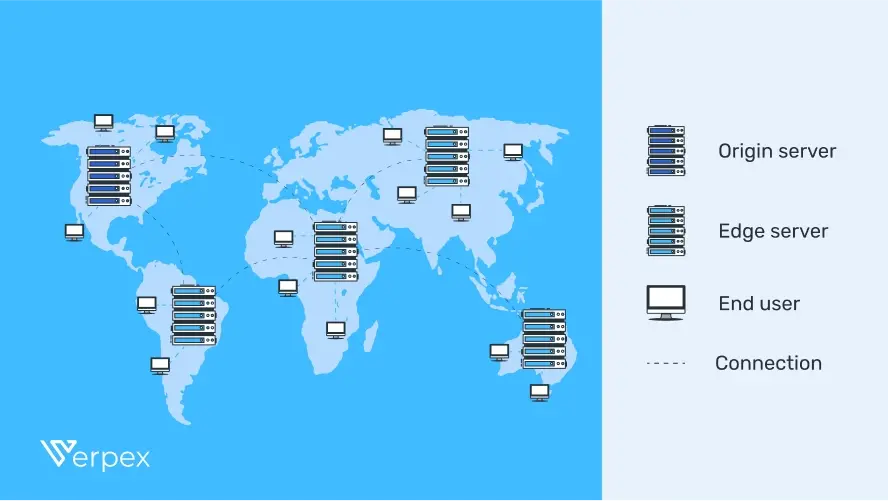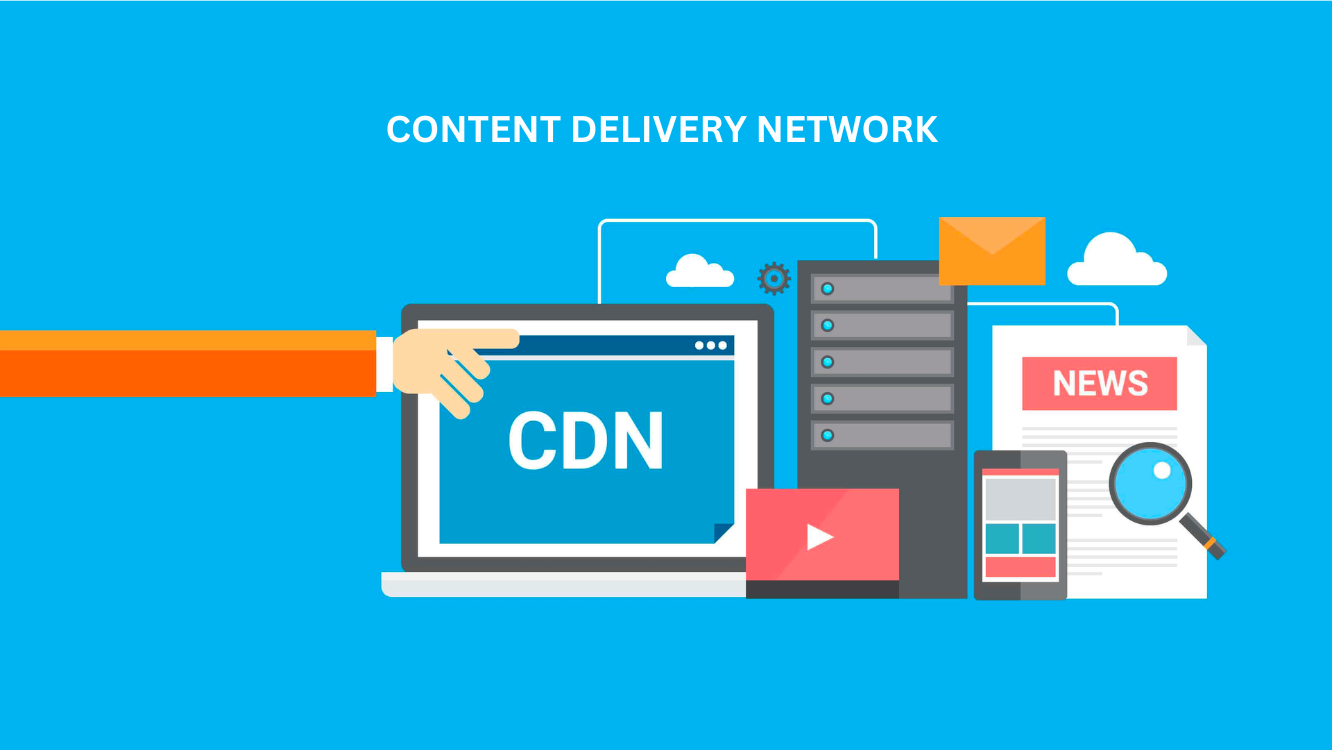Content Delivery Networks (CDNs) are essential to the internet’s infrastructure, with over 12 million CDN-enabled websites in the United States alone. These networks are crucial for speeding up website performance and improving user experience.
This article will explain how CDNs work, their benefits, and their role in modern web hosting. We will also discuss how integrating CDN services with reseller hosting, particularly through providers like Verpex, can enhance service offerings and provide added value for clients.
What Is a CDN?
A Content Delivery Network (CDN) is a widespread network of proxy servers designed to expedite the delivery of internet content(HTML pages, javascript files, images, videos, etc.).
CDNs offer services like video streaming, software downloads, faster web and mobile content, licensed CDN management, and transparent caching.
They also provide tools for CDN performance evaluation, load balancing, multi-CDN switching, analytics, and cloud intelligence.
How do CDNs Work?

A Content Distribution Network enhances internet content loading and connectivity by placing servers at Internet exchange points (IXPs).
IXPs are where different network providers connect and share traffic.
This setup allows CDN providers to lower costs and speed up data transmission.
Other CDN optimizations include
- Strategically located global data centers.
- Improved security measures.
CDN Caching
CDN caching, similar to browser caching, speeds up content delivery by storing your website's files on optimized proxy servers.
This optimized model of cached content;
- Allows nearby visitors faster access
- Reduce bandwidth consumption
- Enhances user experience
- Ensures reliable content delivery.
CDN Vs. Hosting: What’s the Difference?
Modern websites require more than traditional hosting can offer, and CDNs bridge this gap, enhancing but not replacing traditional hosting for superior user performance.
| Feature | Traditional Hosting | CDN (Content Delivery Network) |
|---|---|---|
| Role in Hosting | Primary Hosting Service. | Works alongside hosting providers, not as a replacement. |
| Content Caching | Relies on a single server location. | Adds a network of global servers caching website multimedia. |
| Content Delivery Speed | Dependent on the server's physical location. | Faster delivery due to servers being closer to user locations. |
| Server Distribution | Single location hosting | Distributes content from multiple global locations. |
| Integration | Standard hosting features. | User-friendly, and compatible with platforms like WordPress for easy installation. |
At Verpex, we offer CDN integration through Cloudflare as part of our cPanel licenses. In as simple as two clicks, you can connect your Cloudflare to your cPanel with the Cloudflare add-on.
The Role of CDNs in Reseller Hosting
For resellers, integrating CDN services into your hosting solutions can significantly elevate the quality of service you offer. Verpex, for instance, includes CDN integration options through platforms like Cloudflare within their cPanel licenses. This integration allows resellers to:
Boost Site Performance: By offering CDNs, resellers can help clients' sites load faster, which is crucial for maintaining visitor engagement and improving SEO rankings.
Enhance Security: CDNs provide additional security layers, including DDoS protection and TLS/SSL certificates, which are crucial for safeguarding client data.
Reduce Costs: By minimizing the data load on origin servers, CDNs help cut down on overall hosting expenses; a cost-saving that resellers can pass on to clients.
Advantages of Onboarding a CDN for Resellers
Improved Content Availability: Ensures that high traffic does not disrupt the client's website functionality.
SEO Benefits: Faster loading times contribute to better search engine rankings.
Cost Efficiency: Effective content caching reduces the need for extensive server resources, lowering operational costs.
Advantages of Onboarding a Content Delivery Network (CDN)
Faster Loading Times: CDN distributes content from a closer location, speeding up website loading. This increases visitor engagement and reduces bounce rates.
Reduced Bandwidth Costs: CDNs minimize data load on origin servers through caching, cutting down hosting expenses.
Improved Content Availability: CDN handles high-traffic and hardware issues better, preventing website disruptions, especially for high-traffic sites.
Enhanced Security: CDNs protect against DDoS attacks by managing increased traffic and using Web Application Firewalls (WAF) to block suspicious activities.
Better SEO Ranking: Faster websites get higher rankings on search engines like Google, so using a CDN can boost your website's SEO effectiveness.
CDN Security Features
CDN services prioritize security and data protection, offering robust measures to enhance website safety and user experience.
- Provides TLS/SSL certificates for authentication, encryption, and integrity.
- Ensures secure content delivery, improving visitor experiences.
- Includes DDoS mitigation and other security optimizations.
- Uses encryption protocols to secure data during transfer.
- Features password restrictions for authorized access to accounts and files.
Image CDN
Image CDNs focus on transforming, configuring, optimizing, and delivering images.
They compress images significantly and act like APIs to modify and optimize website images.
An image CDN URL specifies the image's size, format, and quality, allowing easy creation of different image versions for various needs.
Unlike build-time optimization scripts, image CDNs generate new image versions on demand, making them more effective for creating unique images for each client.
CDNs and Mobile App Performance

Integrating Content Delivery Networks (CDNs) with mobile applications is essential for boosting app performance and fine-tuning user experiences.
Speedy Content Delivery: By caching content at edge/CDN servers close to users, CDNs significantly accelerate load times for images, videos, and other media in mobile apps.
Reduced Latency: Content distribution across various geographic locations cuts down the data travel distance. This, in turn, reduces network latency and boosts app responsiveness.
Handling High Traffic: CDNs effectively manage sudden traffic surges, maintaining consistent performance for mobile apps during high user engagement periods.
Superior User Experience: Reliable and swift content delivery leads to a smoother app experience, crucial for user retention in competitive markets..
Global Reach: CDNs ensure efficient content delivery to users worldwide, critical for apps with a global audience.
Content Optimization for Mobile: They dynamically adjust content, like image and video compression, for various mobile devices and network conditions, balancing performance and quality.
Cost Efficiency: By minimizing data transfer from the origin server and optimizing delivery, CDNs can reduce hosting and operational costs for app developers.
Top CDN Service Providers
The CDN market is rapidly growing, with an expected annual growth rate of 28% from 2020 to 2025, leading to a wide range of providers.
Key players include:
Cloudflare: Extremely popular, serving over seven million websites globally with 180+ data centers.
StackPath: Highly rated, with global data centers, and offers a free private EdgeSSL certificate. Over 170,000 websites use it, predominantly in the US.
Sucuri: Known for robust security against DDoS, malware, and hackers, also boosts site speed with advanced technology.
KeyCDN: Uses a pay-as-you-go model, providing features like Gzip compression, real-time reports, instant purge, two-factor authentication, and DDoS protection. Used by over 8,000 websites.
Rackspace: Offers managed cloud services and a CDN, enhancing performance for e-commerce and web apps. Pay-as-you-go pricing, with 400,000+ US-based website users.
Google Cloud CDN: Affordable, leveraging Google’s network with 90+ data center locations, integrates with Google Cloud Platform, and includes a free SSL certificate.
CDN Interoperability with Existing IT Infrastructure

Onboarding a Content Delivery Network (CDN) with existing IT infrastructure is crucial for ensuring smooth operation and maximizing the benefits of both systems.
Let’s quickly review how CDNs can interoperate effectively with current IT setups:
- Cloud Integration
Modern CDNs easily integrate with various cloud services and platforms.
This allows businesses to leverage cloud storage alongside CDN caching, optimizing content delivery and storage simultaneously.
- APIs for Customization
CDNs offer APIs that allow businesses to customize how they interact with their existing IT infrastructure, ensuring that integration is tailored to specific operational needs.
- Scalability with Existing Networks
CDNs can scale up or down according to the needs of the business, complementing the existing network infrastructure without causing disruptions or requiring major changes.
- Network Performance Optimization
CDNs strategically distribute web content in various locations. This approach boosts network performance and reduces load times, delivering customer satisfaction.
- Load Balancing Capabilities
CDNs offer load balancing which helps distribute web traffic evenly across multiple servers, preventing any single server from becoming a bottleneck. This means enhanced resilience and efficiency of the IT infrastructure.
- Analytics and Reporting Tools
Integration with CDN analytics tools can provide valuable insights into content delivery and user engagement. This, in turn, facilitates data-driven decision-making for IT strategy.
- Custom Caching Rules Businesses can set custom caching rules in the CDN to align with their IT policies and data management strategies, ensuring a harmonious operation between the two systems.
Conclusion
CDNs are increasingly popular among both large and small companies, enhancing traditional hosting with improved security and performance. For resellers, adding a CDN to their hosting packages not only boosts website performance, loading times, and security but also offers significant value.
This integration helps provide more competitive, cost-effective solutions by reducing bandwidth usage, thereby lowering hosting costs and improving user experience.
While it is important to maintain traditional web hosting supplementing it with a CDN can greatly enhance service offerings, making the investment in CDN technology both worthwhile and strategic for growth in the hosting industry.
Frequently Asked Questions
Is web hosting free?
There are some web hosting providers that will host your site free of charge. However, there’s a catch to this type of arrangement. There are many limitations to free web hosting. The shared resources mean that the server won’t have enough power to keep everything running smoothly, and it isn’t reliable enough.
What is web hosting bandwidth?
Bandwidth means the data amount that can be transferred from the webserver at any given point in time.
How do I get a CDN for my website?
Many web hosting services like Verpex offer an easy one-click CDN setup, often through Cloudflare. This simplifies the process of integrating a CDN with your website
What makes Vintage Story server hosting different from other game hosting services?
Vintage Story hosting is optimized specifically for the unique mechanics and gameplay of Vintage Story, focusing on seamless survival, crafting experiences, and realistic environmental interactions.

I've been navigating the web hosting waters for years now. As the Chief Editor at Verpex, I team up with some awesome writers to dish out the good stuff on hosting. Got a Master's in Journalism, so I always have an eye out for quality. Whether you're just dipping your toes or you're a seasoned surfer, I'm here to make everything web hosting feel like a breeze
View all posts by Julia Lozanov




















